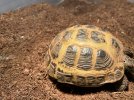nnnoahhhhhhh
New Member
Hi, I noticed quite a few lines all around my Russian’s lower scutes. I don’t know much about growth and was wondering if they looked concerning of if I am being paranoid? They don’t feel any “softer” than the rest of her shell, but they feel like significant ridges.
Also less related, the brownish spot on the top pf her front scute- is that bad?
I’m so sorry for not knowing more about her shell.
Thank you.
Also less related, the brownish spot on the top pf her front scute- is that bad?
I’m so sorry for not knowing more about her shell.
Thank you.



